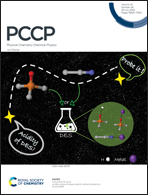A first-principles study of exciton self-trapping and electric polarization in one-dimensional organic lead halide perovskites†
Abstract
Revealing the origin of self-trapped excitons is a prerequisite for further improving the photoluminescence efficiency of low-dimensional organic perovskites. Here, the microscopic formation mechanism of intrinsic self-trapped excitons in one-dimensional (1D) C4N2H14PbX4 (X = Cl, Br and I) systems is investigated, and the polarization–luminescence relationship is established. Our results show that 1D-C4N2H14PbX4 has a low electronic dimension (flat band characteristics), which facilitates the formation of intrinsic self-trapped excitons. The potential well formed by local distortion of the [PbX6] octahedron is the origin of exciton self-trapping. Combined with the electronic density of states and partial charge density, we further confirmed the existence of intrinsic self-trapping excitons in 1D-C4N2H14PbX4. In addition, we found that the breaking of the central inversion symmetry will induce electric polarization, which greatly improves the transition probability of electrons. These results could potentially offer a new direction for improving the luminescence properties of 1D organic lead halide perovskites.



 Please wait while we load your content...
Please wait while we load your content...